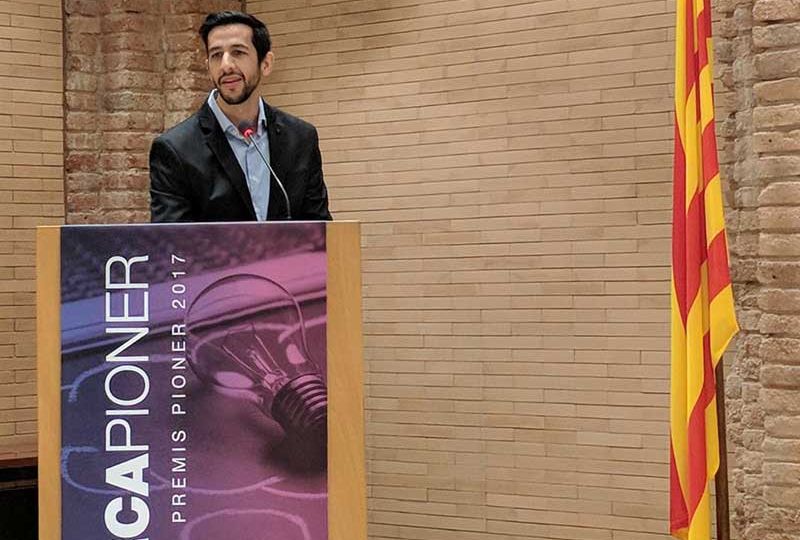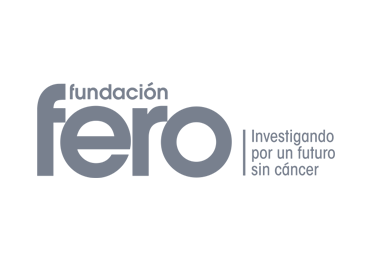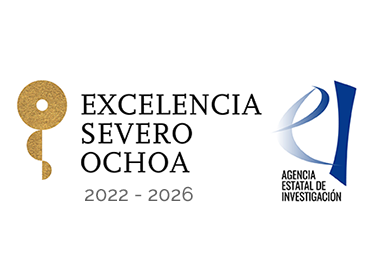
Celebrated earlier this week, Daniel Massó-Vallés, Post-Doctoral Fellow of VHIO’s Mouse Models of Cancer Therapies Group led by Principal Investigator Laura Soucek, has received one of this year’s Pioneer Awards from the Research Centres of Catalonia (CERCA) Institute. Now in its fourth annual edition, CERCA’s Pioneer Awards recognize up-and-coming research talents who have presented a doctoral thesis with results promising commercial exploitation and technology transfer for societal gain.
Entitled, Inhibiting Myc and the Myc dependent inflammatory response as cancer therapies, research lines presented during his thesis defense described the therapeutic and commercial potential of not one, but two novel anti-cancer approaches pioneered by the Soucek lab. First, the repurposing of ibrutinib, a small-molecule Bruton´s tyrosine kinase (BTK) inhibitor for the treatment of pancreatic cancer, and second, the promise of Omomyc in successfully blocking the oncoprotein Myc which is found deregulated in the majority of human cancers.
The therapeutic switching of ibrutinib for the treatment of pancreatic cancer
Ibrutinib is a targeted therapy inhibiting the function of Bruton’s tyrosin kinase (BTK). This agent was first approved by the FDA in 2013 to halt tumor cell growth in various blood cancers such as chronic lymphocytic leukemia due to its essential role in the maturation of B cells (B lymphocytes). In addition to B lymophocytes, BTK is also expressed in many other cell lines, which has inspired several research teams to explore the therapeutic effect of BTK inhibition across other tumor types.
Thanks to the subsequent mounting of evidence, ibrutinib continues to represent a ‘poster board’ example of drug repurposing – either as monotherapy, in combination with cornerstone anti-cancer treatments, or paired with immune-based strategies. Research led by Laura previously showed the mast cell-inhibiting properties of ibrutinib in mouse models with pancreatic ductal adenocarcinoma; the most common and aggressive of pancreatic cancers exhibiting significant mast-cell infiltration, rapid cancer growth and metastatic spread.
First authored by Daniel Massó-Vallés and published in Cancer Research* in 2015, their findings revealed ibrutinib’s potent anti-fibrotic effect which, when combined with chemotherapy, extended survival in mice. This discovery led to the successful filing of a patent issued by Pharmacyclics, with Laura Soucek, Toni Jauset González, Graduate Student at her lab, and Daniel as joint inventors.
These promising preclinical results coupled with the proven safety and efficacy of this agent in the clinic, triggered the fast-track initiation of a phase II/III clinical trial to validate the administration of ibrutinib combined with standard chemotherapy for the treatment of pancreatic cancer, results from which are eagerly anticipated. Upon successful verification, this novel approach should bring significant benefits to patients suffering from this notoriously difficult-to-treat disease.
“Upon validation in clinical studies, ibrutinib would be immediately approved by EMA and the FDA in this setting, thus representing a much needed and more effective therapeutic avenue for the 338.000 new cases of pancreatic cancer diagnosed each year. Furthermore, emerging data suggests that this therapy could also prove successful in the treatment of other solid tumor types including melanoma, breast and lung cancers, which would significantly accelerate its commercialisation”, observes Daniel.
Translating Omomyc-based therapy into clinical application and direct benefit for patients
The second focus of his thesis centred on Omomyc, a novel cell-penetrating peptide designed by Laura Soucek, ICREA Professor and Principal Investigator of VHIO´s Mouse Models of Cancer Therapies Group.
Having shown Omomyc as a viable and direct Myc inhibitor, whose application could be readily extended to multiple types of cancer irrespective of mutational profile or tissue of origin, Laura co-founded the spin-off company Peptomyc S.L. with Marie-Eve Beaulieu, formerly a postdoctoral fellow in her lab.
Built on research led by Laura over the last 20 years, her team’s dedicated efforts are now focused on developing Omomyc as the first ever clinically viable inhibitor of Myc. Such a breakthrough would ring in essential new anti-cancer weaponry for the treatment of non-small cell lung cancer, triple-negative breast cancer, and glioblastoma – all of which have a dismal prognosis and are in desperate need of new therapeutic opportunities.
Spurred by their reports that this peptide can be successfully administered intranasally and that no resistance has yet been observed in the preclinical models under study, Peptomyc has since marked important milestones in de-risking Omomyc from a proof-of-concept development stage into a successful Phase I/II product for the future licensing to a pharmaceutical company.
These successes have led to the filing of two patents and most recently, as revealed by Daniel during his thesis defense, a new Omomyc peptide variant is showing great promise in more effectively tackling triple-negative breast cancer.
An estimated 15 – 20% of breast cancer cases belong to the triple-negative subtype which is one of the most aggressive. Importantly, despite significant advances in anti-cancer therapies, metastatic disease remains the underlying cause of death in the majority of breast cancer patients who succumb to their disease (up to 80% of cases in some subtypes).
Those present during Daniel’s thesis defense gained a first-outing glimpse into Omomyc’s ability to also deliver its powerful anti-cancer blows against metastatic disease across some of the most aggressive tumor types including triple-negative breast cancer. In view of its exquisite and preclinically proven anti-metastatic properties, Laura’s group is currently registering a new patent to protect this new molecular entity and promote its commercial development.
Commenting for VHIO Communications, Daniel concludes, “In order to finally deliver Myc inhibitors to the clinic, we must continue to advance precious insights into Myc biology and function as well as determinedly pursue targeting strategies that favor the pairing of current therapies with novel agents”.
###
Reference:
* Massó-Vallés D, Jauset T, Serrano E, Sodir NM, Pedersen K, Affara NI, Whitfield JR, Beaulieu ME, Evan GI, Elias L, Arribas J, Soucek L. Ibrutinib exerts potent antifibrotic and antitumor activities in mouse models of pancreatic adenocarcinoma. Cancer Res.75(8):1675-81.









